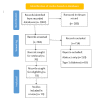Women With Polycystic Ovary Syndrome: A Review of Susceptibility to Type 2 Diabetes
- PMID: 36751233
- PMCID: PMC9897680
- DOI: 10.7759/cureus.33390
Women With Polycystic Ovary Syndrome: A Review of Susceptibility to Type 2 Diabetes
Abstract
The polycystic ovarian syndrome affects many women today. Previous research has demonstrated a direct link between it and serious ailments such as type 2 diabetes, heart disease, and infertility. Originally thought to be a reproductive disorder, polycystic ovarian syndrome (PCOS) is now understood to be a metabolic and psychological disorder. Women of reproductive age suffering from PCOS undergo hormonal imbalances in which progesterone, insulin, and testosterone are produced in excess. PCOS exhibits a variety of characteristics as well as a heterogeneity of symptoms, including acne, hirsutism, androgenic alopecia, irregular menstruation, infertility, obesity, and mood disorders like despair and anxiety. Chronic anovulation, hyperandrogenism, type 2 diabetes, dyslipidemia, and an elevated threat of coronary artery disease are some of its defining characteristics. PCOS develops due to interacting genetic and environmental factors. From a gynaecological curiosity, it grew into a multisystem endocrinopathy. It is fascinating to learn how hormonal issues result in gynaecological problems. Insulin resistance, compensatory hyperinsulinism, and an increase in ovarian androgenic hyperresponsiveness to circulating insulin are all directly related to hyperandrogenism and anovulation. Independent of weight, insulin resistance is more common with PCOS and plays a crucial role in the syndrome's metabolic and reproductive complications. Anovulation, polycystic ovaries, and elevated luteinizing hormones, which increase circulating androgen, are all caused by a reduction in follicle-stimulating hormone. High androgen levels cause hyperinsulinemia, which leads cells to become insulin resistant and makes PCOS patients more likely to develop diabetes mellitus. Later research established that women with polycystic ovarian shape and persistent anovulation are the only ones susceptible to insulin resistance. Insulin resistance is thus a distinct characteristic of the condition. The purpose of this review paper is to investigate how PCOS ultimately results in type 2 diabetes mellitus.
Keywords: hyperandrogenism; hyperinsulinemia; insulin resistant; polycystic ovary syndrome; type 2 diabetes.
Copyright © 2023, Layacha et al.
Conflict of interest statement
The authors have declared that no competing interests exist.
Figures
References
Publication types
LinkOut - more resources
Full Text Sources


